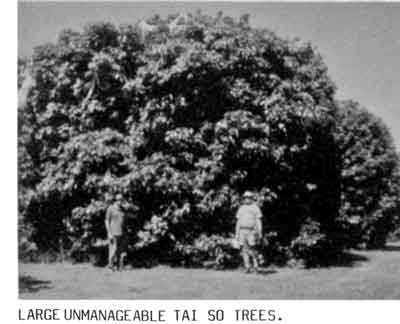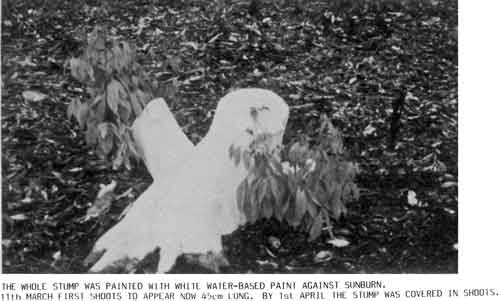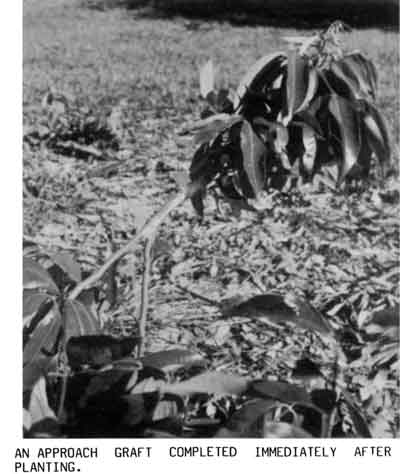
TOP-WORKING LYCHEES
SCIENTIFIC NAME: Litchi chinensis
FAMILY: Sapindaceae
 A number of Tai So trees on the property of Mr Pete Brittain of White Rock have now grown so huge that they are becoming hard to manage. It is difficult to net them properly against bird and bat damage and hard to reach the fruit at the top of the tree with the picking elevator.
A number of Tai So trees on the property of Mr Pete Brittain of White Rock have now grown so huge that they are becoming hard to manage. It is difficult to net them properly against bird and bat damage and hard to reach the fruit at the top of the tree with the picking elevator.
Pete has been marcotting the large-fruited variety FAY ZEE SIU for sale and for his own use. This new variety shows considerable market potential because of its size, small 'chicken tongue' stone and excellent flesh-to-seed ratio. It is sweeter than Tai So and matures about the same time. It is claimed to be a regular cropper.
Where marcots of Fay Zee Siu have been planted back into sites from which large Tai So trees have been removed, growth has been slow, which is not surprising!
It was therefore decided to try to top-work instead of replanting, by approach grafting marcots onto shoots arising from cut-down Tai So stumps. After all, with massive Tai So root systems in the ground, these should force the Fay Zee Siu to grow rapidly and thus get them into crop a lot quicker.
TIMING OPERATIONS
Allow five or more months between time of marcotting Fay Zee Siu and eventually planting them out. Other varieties may take longer. Fay Zee Siu take about 6-8 weeks to root, then spend 1- 3 months in a pot by which time roots should be appearing through the base of the pot. Harden off in semi-shade for two weeks and a further two weeks in full sun.
We started to cut down the Tai So on 7.12.92 after harvest. The marcots would have been done sometime in spring. This is about the right time to marcot lychees, when the bark is beginning to slip. This timing synchronised growth of both varieties ready for approach grafting in April-May.
STUMPING THE TREES
So that everything can be sprinkler-watered, it was decided to remove the pots and plant the marcots in the ground next to the Tai So shoots. This would obviate having to water lots of pots individually out on the block every day and not a stand pipe in sight!
The trick was to estimate how far to cut down the trees so that the resulting shoots from the stumps would be about the right height for approach grafting into the Fay Zee Siu marcots, once they were planted in the ground. After a bit of head scratching and measuring we decided to cut the Tai So trees down to around 1.5-2 ft (45-60cm) above ground, as in the picture. This was done with a chainsaw.
WHAT ABOUT LEAVING BREATHERS?
It is usual to leave a breather or branch to draw the sap until the shoots have formed on the stumps. However, in this case, the bases of the trees had been in deep shade for so many years there wasn't a single thin branch, shoot or anything left. Just the stumps, which seemed to produce shoots all right anyway.

PAINTING THE STUMPS
The cut ends were trimmed and smoothed around the edges, more or less, with a sharp knife to facilitate healing. A spoke shave would have done a better job, but we didn't have one.
Wound paint: The cut ends were immediately painted over with wound paint. This comprised of two fungicides against disease - Benlate 5g and Bravo 10g and an insecticide against borers - Lorsban 10ml per litre of white water-based paint. The stump ends had to be repainted two or three times, as oozing sap tended to wash it off. Stump ends are vulnerable, as many were more than 1 foot across.
Sun protection: The whole stump was then painted with white water-based paint against sun burn. This has to be done thoroughly, as sun on bark that has been shaded for 20 or more years can burn severely. Whitewash gets washed off, so always use paint.
The shoots push out through the paint after about a couple of months. A month after emergence, they grow to about 18 inches (45cm) long. At this stage, make sure marcots go out from the shade house to adequately harden off before planting out.
PLANTING OUT THE MARCOTS
On 1st April (are we fools??) the hardened-off Fay Zee Siu marcots, now showing roots through the pot bases, were planted out 4 or 5 per Tai So stump. The holes were easily dug with a post-hole borer as the stumps had been watered two days previously. A spade was used to widen the holes so that potting compost could be placed beneath and around the roots. A stick was used to compact the compost around the root ball. The potting compost should have a complete fertilizer mixed through it. After planting, the root ball should be about an inch below soil level for watering. Marcots must be thoroughly watered in to exclude all air pockets. The adventitious root system of a marcot is only required to keep it growing until the approach graft has taken. Once taken, the vigour will come from the Tai So root system.
Take advantage of the vigour: Each Tai So had two or more stumps as can be seen in the pictures. To ensure that both sides of a stump are kept alive for adequate healing and to avoid die-back, the marcots should be placed on either side of each stump. Hence there are likely to be a minimum of four marcots per stump. This takes full advantage of the Tai So tree's considerable vigour to rapidly build up strong and well placed Fay Zee Siu scaffold limbs. A large tree can be formed very quickly in this way, resulting in earlier and heavier yields once cropping commences. In temperate fruit trees and vines, it is common practice to top-work so why not with tropical fruits?
Placing the marcot: Position the marcot stems as close as possible to the strongest shoots, tree roots permitting. Actually this was easier than we anticipated. Any Tai So shoots that were thick enough to approach graft were grafted immediately ofter planting. The remainder will be grafted in two to four weeks time, or whenever they are long enough. Be careful not to waggle the marcot about too much, if grafting soon after planting, in case you break the roots off underground.

APPROACH GRAFTING
The method of approach grafting is well enough known without the need for diagrams. It is simply a matter of, in this case, cutting about an 8-cm-long cut on the Tai So shoots and a similar cut on the Fay Zee Siu marcot and tying them together with tape.
Cambiums must match up: First hold the two branches together to see where to make the cuts. Cuts obviously should match each other in length and it is important that they are also of exactly the same width so that the cambiums, which lie just under the bark, can combine quickly to form a strong union. On the thicker stems, I always cut 1.5-2cm tongues on both side in the centres of the cuts and then fit one into the other before tying Cut down to form the tongue on the Tai So (rootstock) and cut up to form the tongue on the Fay Zee Siu (scion variety). This always forms a good union as it increases cambium contact (similar idea to whip and tongue grafting).
Taping up: I like to use clothes pegs or, better still, short lengths of soft wire which are easier to use, to hold the two stems firmly together for tying They make the job a lot easier, otherwise you need two pairs of hands! Make sure the two sides of each cut match up together exactly as you wind around the tape, (2-cm-wide plastic tape is normally used). Try to keep it from creasing up and maintain some tension on it to hold the two cut surfaces firmly together. I usually start tying at the bottom of the graft and work up. Remove the pegs or wire when finished.
Three months later: I leave the tape on for about two and a half months. Never mind if the grafted area swells up underneath as the tape will stretch. I then remove the tape but still leave the Tai So (rootstock) top on for a further two weeks to allow the grafted area to harden up before removing it altogether.
Leave the Fay Zee Siu plants in the ground, no need to remove them. Their roots will help to boost growth and provide stability to the developing tree in the event of cyclones.
What about all the suckers? The numerous other shoots which have not been grafted are allowed to grow on. These will draw the sap, feed back nutrients and keep the stumps active enough to start healing over the cut ends.
There may be a possibility of cleft or bark grafting these in the spring. Spring is the best time to cleft graft according to some authorities. The problem of doing this in the open air, instead of in a protected nursery, is desiccation of the grafts. I intend to try painting over the grafts with white water-based paint as is used a lot in vine grafting down south. Scions will be defoliated so they can be painted over. Could be a complete failure, but we won't know that until we've tried. Budding may also be a possibility.
If this fails, then once the approach grafts are growing away strongly, all those suckers will have to be removed. Cut off cleanly to eliminate base buds, could be a hammer and chisel job. Further suckering may be a problem, but should be less so as the four or more approach grafts per tree take up the vigour.
THE DOLLAR IS WHAT COUNTS
Obviously the subsequent tree will have more than the desirable one main trunk. But higher and earlier yields will bring in more dollars and the dollar is the name of the game!
Future pruning to avoid weak crotches and for good tree shape, as is normally done, would have to be adapted to the four or five stem tree. Perhaps some approach grafting of limbs later on within the tree might give internal support against cyclonic winds.
DATE: May 1993
* * * * * * * * * * * * *
